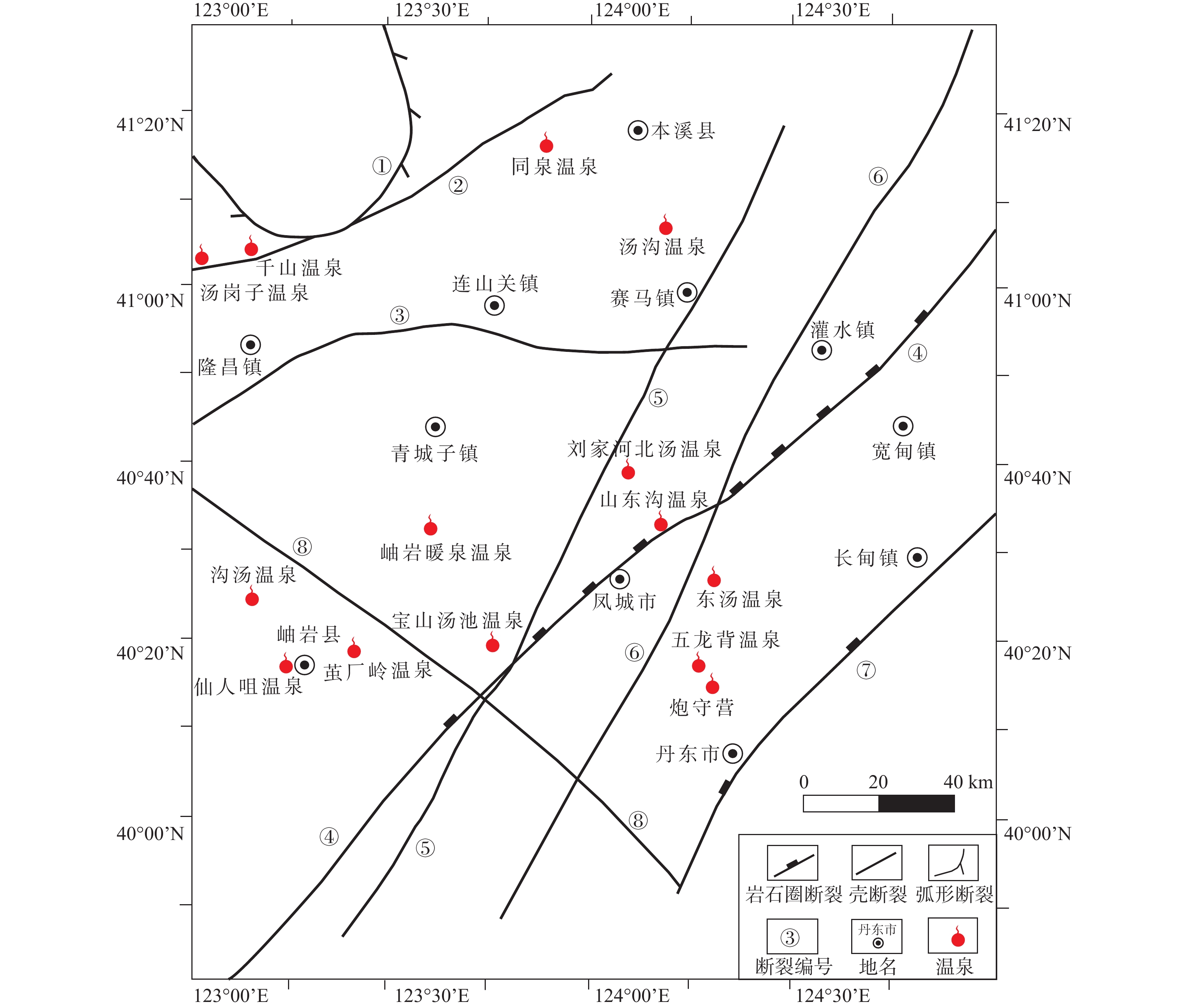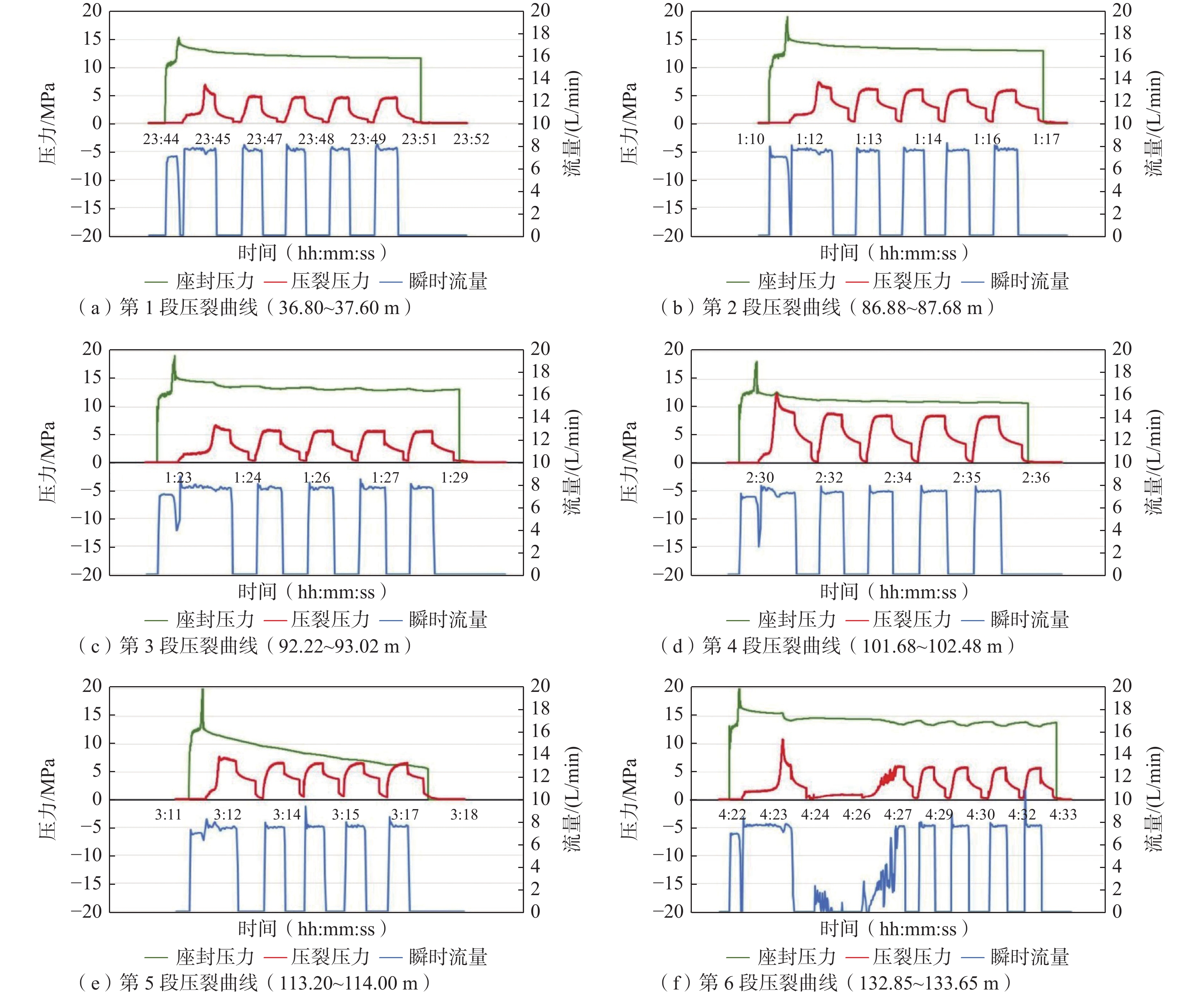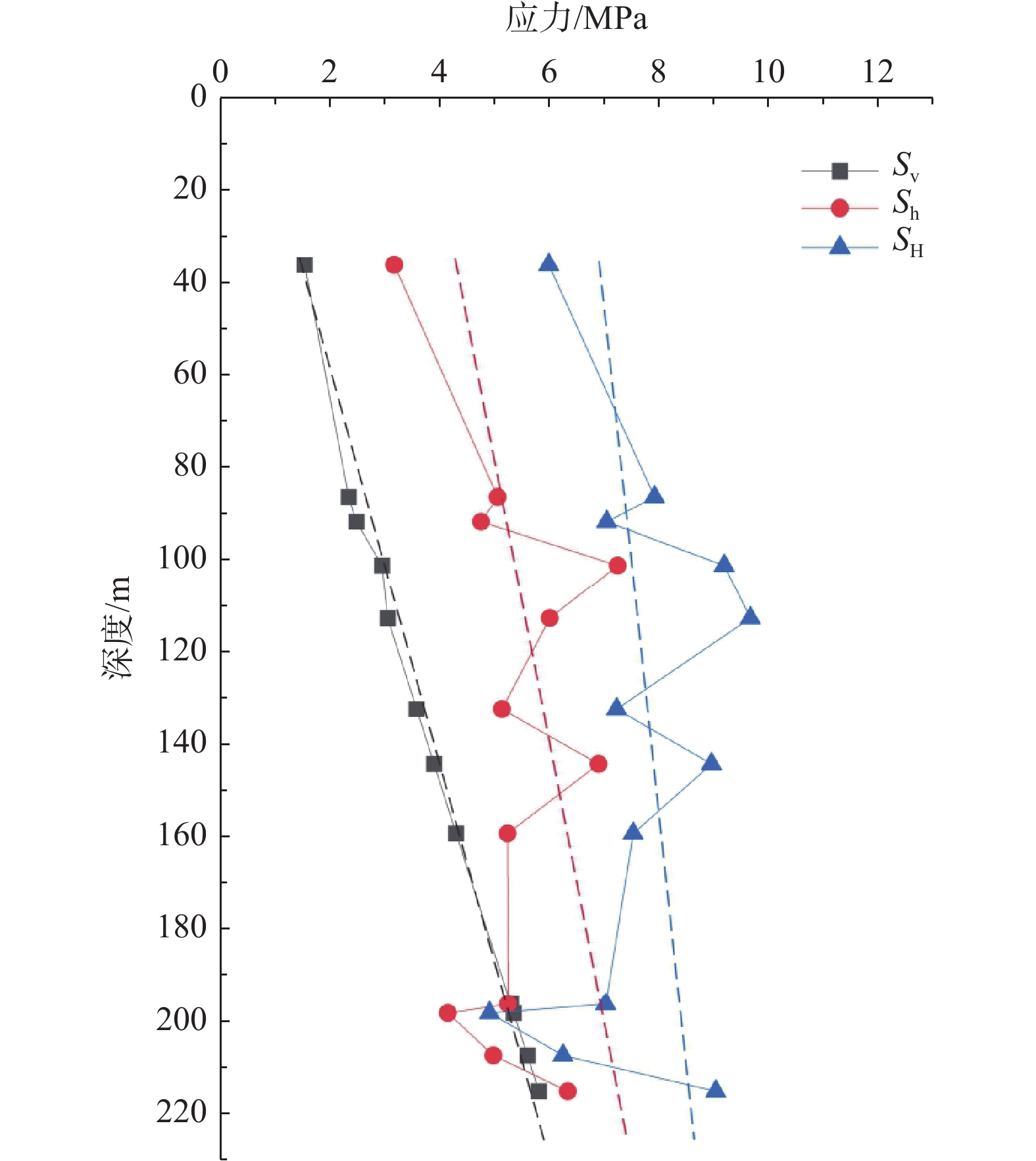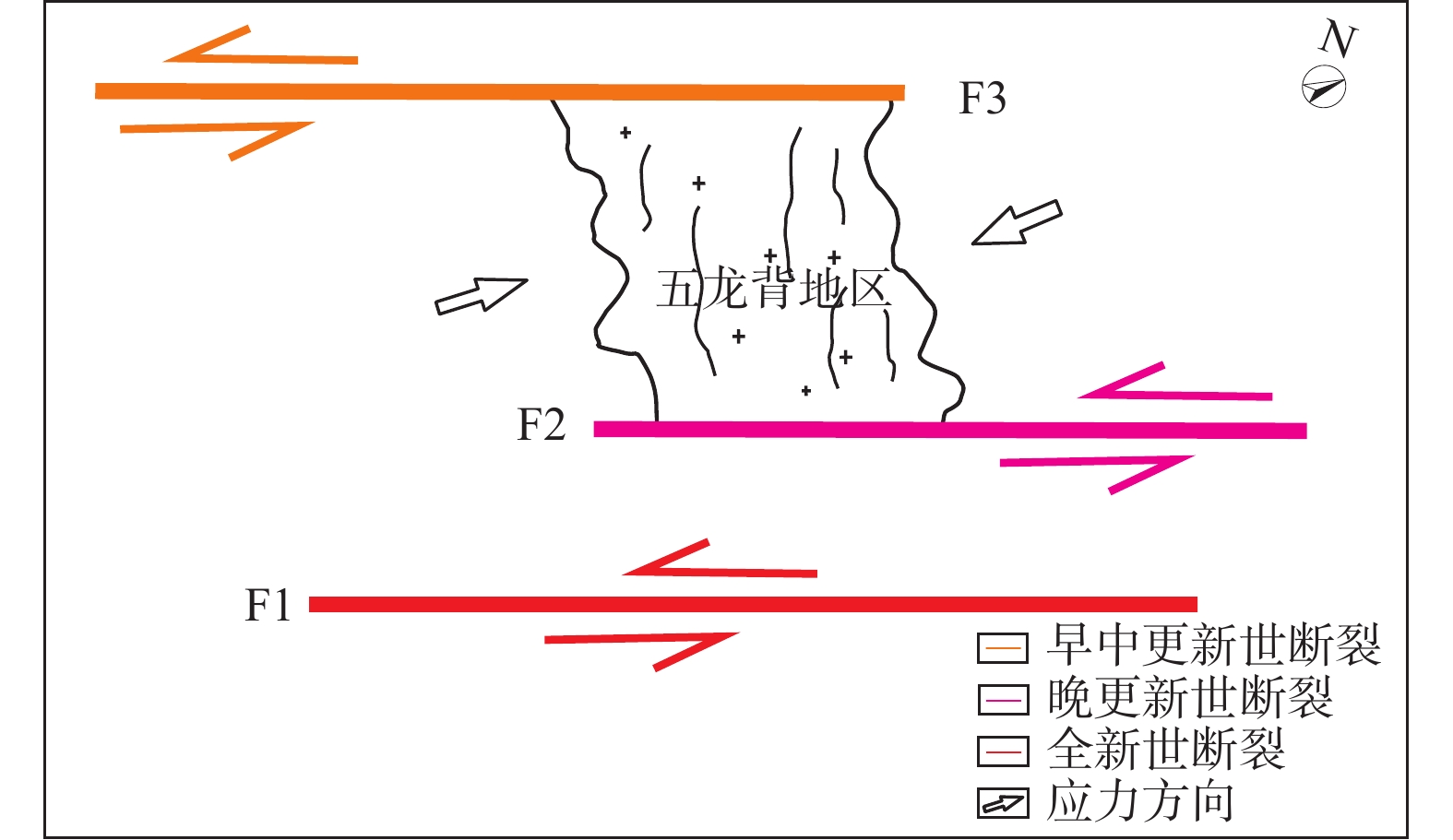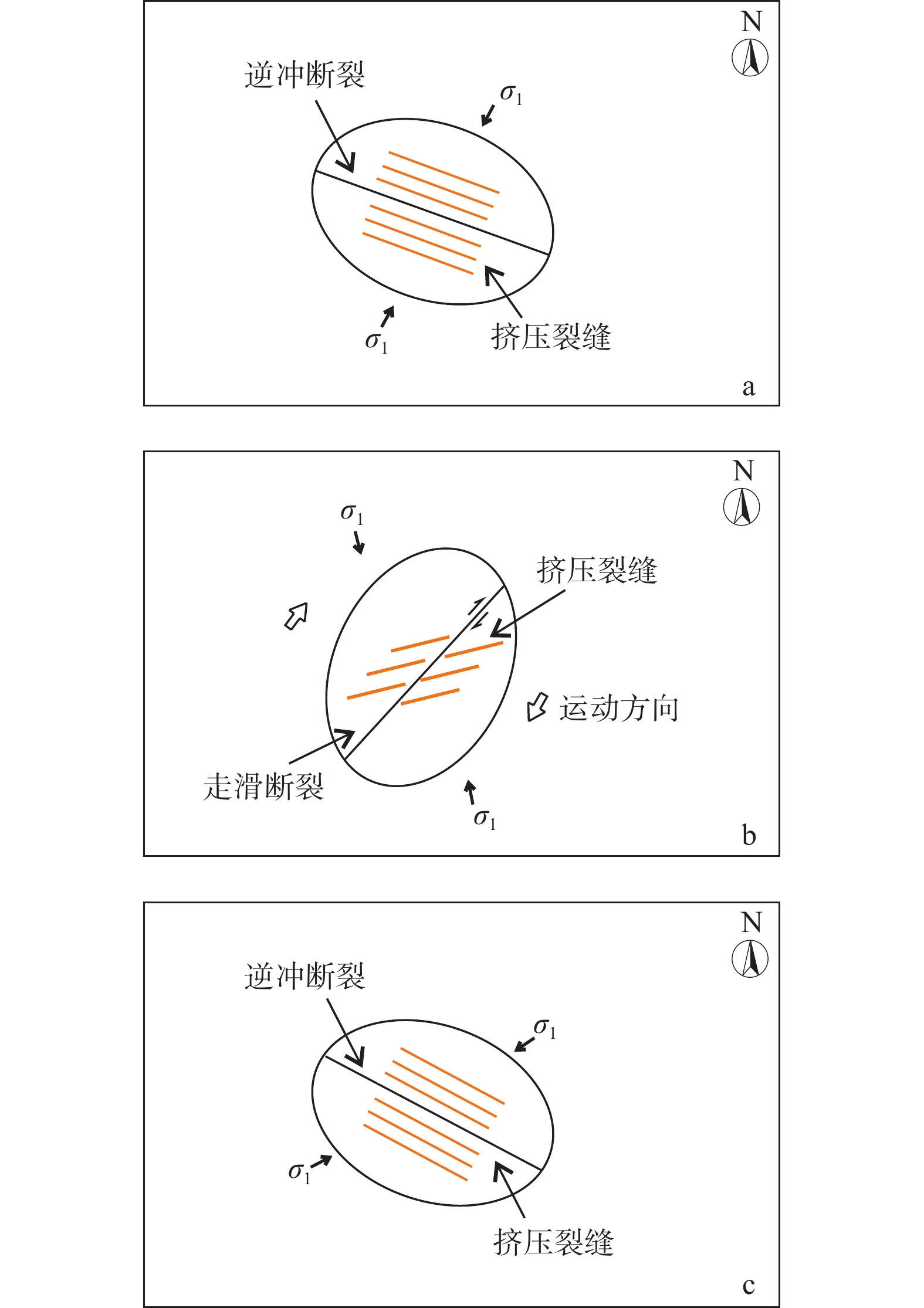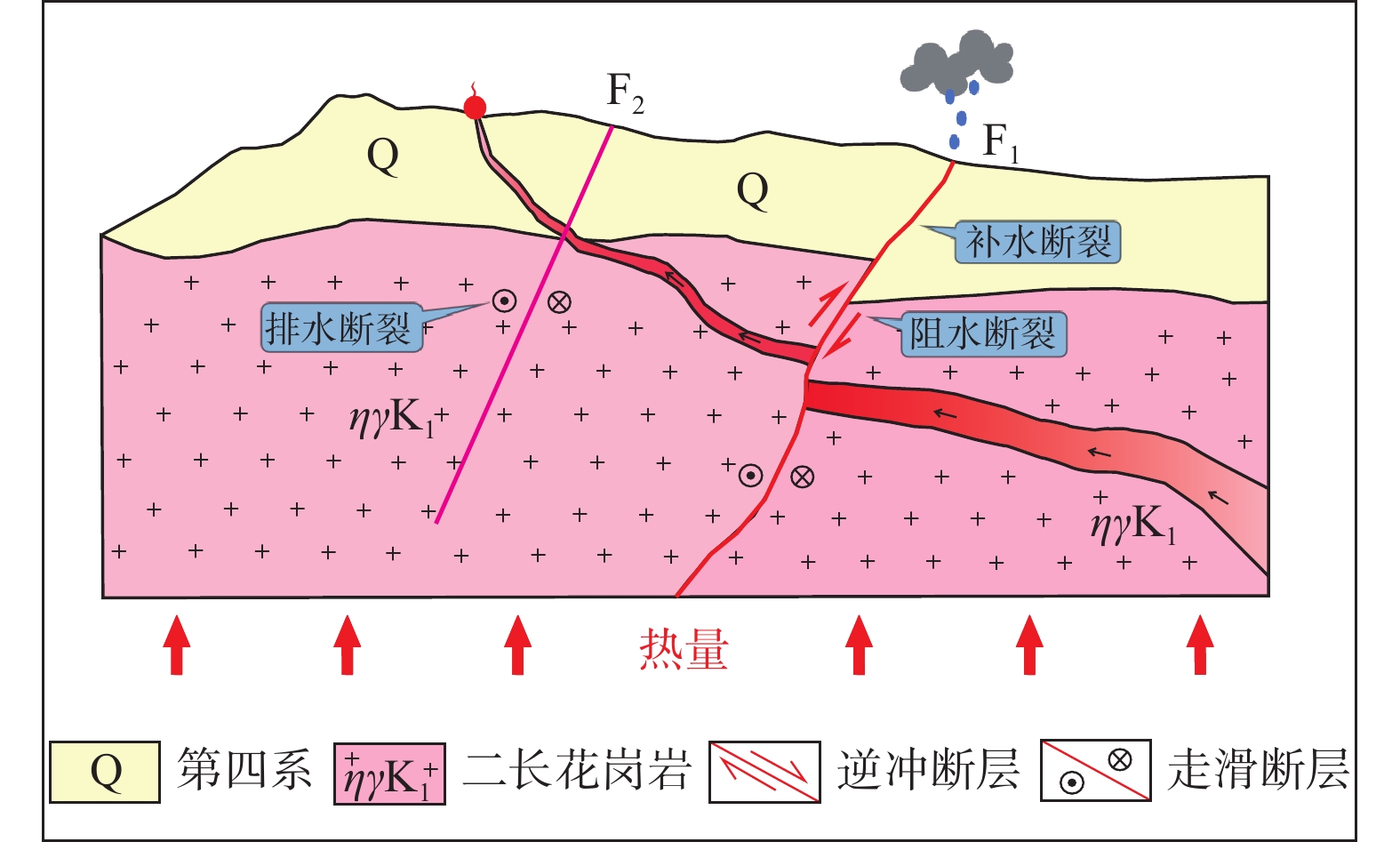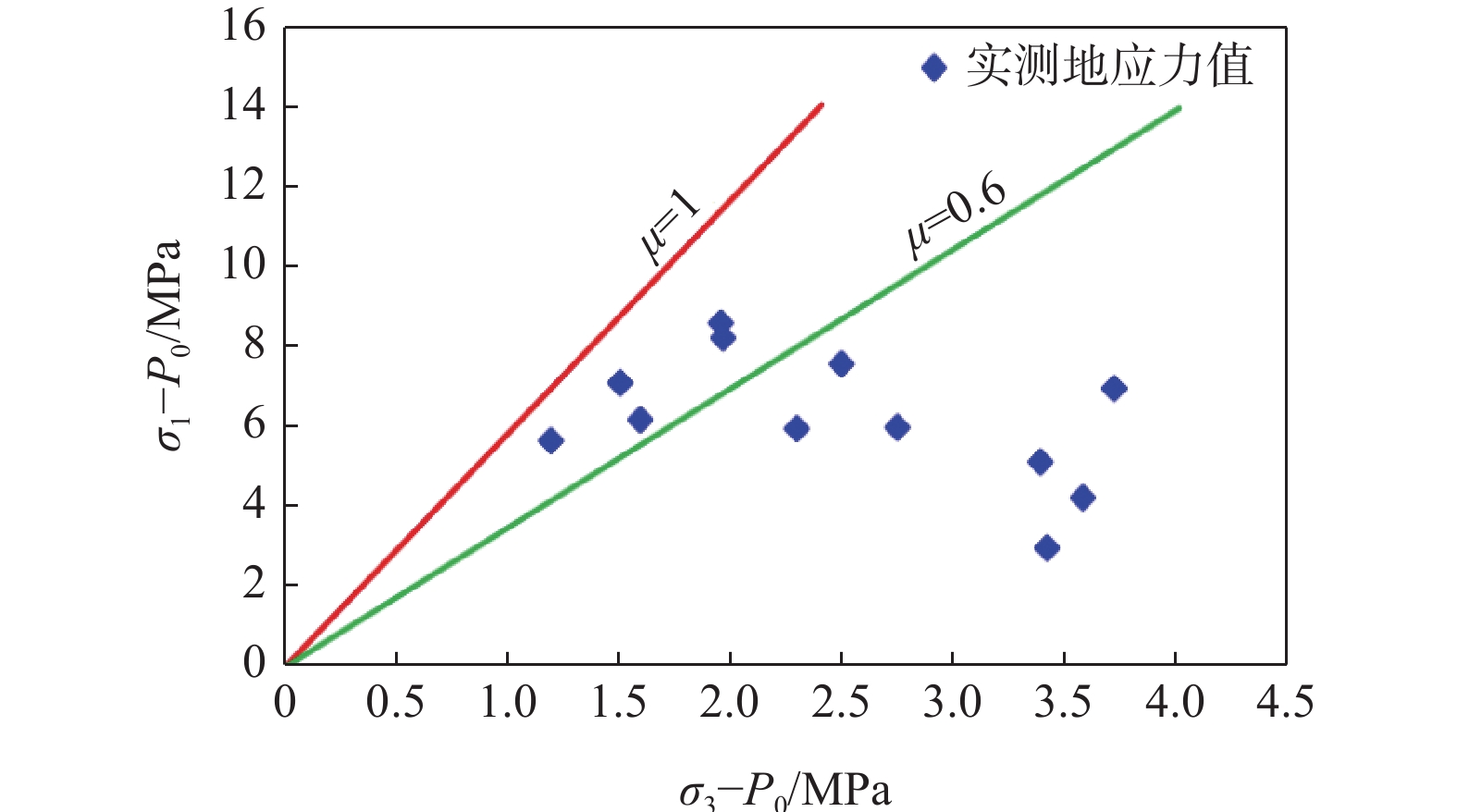Preliminary analysis of the influence of the activity in the Yalu River fault zone on the Wulongbei geothermal hot springs in Dandong under the action of crustal stress
-
摘要:
鸭绿江断裂带为郯庐断裂系的重要分支,现今构造活动强烈,沿断裂带出露温泉60余处,地热资源丰富。为查明断裂带南段五龙背地区的现今地应力状态和断层的活动性,研究断裂活动对温泉地热水体的控制作用和远期影响,采用水压致裂法对该区开展了12个测段的原位地应力测量。测量结果显示,在测段深度36.80~215.50 m范围内,最大、最小水平主应力及垂直主应力值(SH、Sh、Sv)分别为6.00~13.52 MPa、3.18~7.26 MPa和0.97~5.7 MPa,总体而言,3个主应力值呈现随深度的增加而逐渐增大的趋势,最大水平主应力方向以北东向为主;断裂带中段(198.60~207.80 m),主应力关系为SH>Sv>Sh,有利于走滑型活动,具有一定潜力的富水导水条件,断裂带上段(36.80~196.63 m)及下段(215.50 m),SH>Sh>Sv,有利于逆断层活动,热流通道纵向连续性欠佳,导水条件较差;根据现今应力场特征与断裂活动的关系推演,五龙背地区温泉水位下降可能是因为断裂在压应力作用下活动,导水系统空间受挤压逐渐缩小,其他方向径流排泄增多,导致温泉水源供给减少;基于库仑摩擦失稳理论,断裂带36.80~113.20 m深度范围内的地应力值达到了其活动需要的应力临界值下限,将来有可能发生错断活动,温泉地热水体的补给通道可能受到断裂活动的影响而发生改变。研究成果在断裂对温泉地热水体控制作用研究方面具有一定的理论意义,并积极探索了断裂带附近地应力测量在地热研究领域中的应用思路。
Abstract:The Yalu River fault zone is an essential branch of the Tanlu fault system with intense present-day tectonic activity. Over 60 hot springs are exposed along the fault zone with abundant geothermal resources. In order to find out the present-day crustal stress state and fault activity in the Wulongbei area of the southern section of the fault zone and to study the control and long-term influence of the fault activity on the geothermal water bodies of hot springs, in-situ stress measurements of 12 sections were carried out in the area by hydraulic fracturing method. The results showed that the maximum and minimum horizontal principal stresses (SH and Sh) range from 6.00 to 13.52 MPa and 3.18 to 7.26 MPa, respectively, in the depth range of 36.80–215.50 meters. In general, the three principal stresses showed an increasing trend with depth; in the middle section of the fracture zone (198.60–207.80 m), the three principal stress values meet the relation of SH>Sv>Sh, which is favorable to the strike-slip activity and has some potential for water-rich hydraulic conductivity, while the three principal stress values of the upper section (36.80–196.63 m) and lower section (215.50 m) accord with SH>Sh>Sv, which is favorable to the reverse fault activity, with poor longitudinal continuity of heat flow channels and poor hydraulic conductivity. Based on the present-day relationship between stress field characteristics and fault activity, it is deduced that the decline of the hot spring level in the Wulongbei area may be due to the fault activity under compressive stress, which gradually reduced the space of the hydraulic conductivity system by extrusion, causing the increase of discharge of runoff in other directions and the reduction of hot spring water supply. Based on the Coulomb frictional instability theory, the in-situ stress value in the depth range of 36.80–113.20 m in the fault zone reaches the lower limit of the critical stress value required for its activity. There is a possibility of dislocation in the future, and the fault activity may change the hot spring geothermal water supply channel. The research results have theoretical significance in studying the role of faults in controlling hot spring geothermal water and applying in-situ stress measurements near fault zones in geothermal research.
-

-
图 2 主要断裂构造与温泉发育关系图(据李文庆,2015修改)
Figure 2.
表 1 鸭绿江断裂带温泉状况
Table 1. List of hot springs in the Yalu River fault zone
温泉名称 出露位置 采水量/(m3·d−1) 水温/℃ 温泉井数(利用数/总数) 五龙背 振安区五龙背镇 2300 72 13/19 炮守营 元宝区炮守营村 700 53 4/4 东汤 凤城市东汤镇 2400 73 2/2 草河 凤城市草河经济区 580 40 0/6 宝山 凤城市宝山镇 120 46 1/1 北汤 凤城市刘家河镇 / 45 1/2 汤池子 东港市汤池镇 / 38 1/2 北井子 东港市北井子镇 240 53 1/1 椅圈 东港市椅圈镇 200 71 3/3 合计 / 6990 / 26/39 表 2 地应力钻孔水压致裂地应力测量结果
Table 2. Results of the in-situ stress measured by hydraulic fracturing method in the test borehole
测段深
度/m破裂压力
Pb/MPa重张压力
Pr/MPa瞬时关泵压力
Ps/MPa抗拉强度
T/MPa孔隙水压力
P0/MPa最大水平主应力
SH/MPa最小水平主应力
Sh/MPa垂直主应力
Sv/MPa最大主应
力方向36.80 7.01 4.42 2.82 2.59 0.36 6.00 3.18 0.97 NE 58.94° 86.88 7.39 5.58 4.22 1.81 0.85 9.29 5.07 2.30 92.22 6.73 5.45 3.87 1.28 0.90 8.64 4.77 2.44 101.68 12.51 8.08 6.26 4.43 1.00 13.52 7.26 2.69 113.20 7.83 6.16 4.91 1.67 1.11 10.93 6.02 3.00 132.85 10.98 5.61 3.85 5.37 1.30 9.00 5.15 3.52 144.70 12.40 8.92 5.49 3.48 1.42 12.40 6.91 3.83 159.70 8.74 5.07 3.68 3.67 1.57 8.93 5.25 4.23 NE 80.53° 196.63 6.68 4.88 3.33 1.80 1.93 8.59 5.26 5.20 198.60 5.01 3.66 2.21 1.35 1.95 6.37 4.16 5.25 207.80 7.57 4.63 2.95 2.94 2.04 7.94 4.99 5.50 215.50 9.91 5.78 4.24 4.13 2.11 10.59 6.35 5.70 NE 77.78° 注:地应力测量孔静水位5.63 m -
[1] ANDERSON E M, 1951. The dynamics of faulting and dyke formation with applications to Britain[M]. 2nd ed. Edinburgh: Oliver and Boyd: 7-22.
[2] BYERLEE J, 1978. Friction of rocks[J]. Pure and Applied Geophysics, 116(4-5): 615-626. doi: 10.1007/BF00876528
[3] CHANG J Y, 2014. Investigation on the application status of hot spring resources in Dandong[J] Sichuan Building Materials, 40(4): 106-107, 109. (in Chinese)
[4] CHEN M X, WANG J Y, DENG X, 1996. The map of geothermal system types in China and its brief explanation[J]. Geological Sciences, 31(2): 114-121. (in Chinese with English abstract)
[5] CHEN P, 2018. The formation conditions and main controlling factors of geothermal resources in Songjianghearea of Changbai Mountain[D]. Changchun: Jilin University. (in Chinese with English abstract)
[6] CHEN Q C, FAN T Y, LI X S, et al. , 2014. In situ measurements and comprehensive research on the present crustal stress of Northern South China Sea[J]. Chinese Journal of Geophysics, 57(8): 2518-2529. (in Chinese with English abstract)
[7] CHENG X F, XU S G, ZHANG S T, 2008. Characteristics of geothermal geology and genetic model of the Anning hot spring in Yunnan Province[J]. Hydrogeology and Engineering Geology, 35(5): 124-128. (in Chinese with English abstract)
[8] CUOCO E, MINISSALE A, DI LEO A M, et al. , 2017. Fluid geochemistry of the Mondragone hydrothermal systems (southern Italy): water and gas compositions vs. geostructural setting[J]. International Journal of Earth Sciences, 106(7): 2429-2444. doi: 10.1007/s00531-016-1439-4
[9] DONG N T, WU G L, WANG G Q, et al. , 1989. The basic geological features of the yalujinga fracture belt and the metallogenic regularities[J]. Jilin Geology, 8(4): 1-25. (in Chinese with English abstract)
[10] DONG Y X, HUANG H X, REN L, et al. , 2021. Geology and development of geothermal field in Neogene Guantao Formation innorthern Bohai Bay Basin: A case of the Caofeidian geothermalheating project in Tangshan, China[J]. Petroleum Exploration and Development, 48(3): 666-676. (in Chinese with English abstract)
[11] DU J J, CHEN Q C, MA Y S, et al. , 2013. Faults activity and stress state in the northeast segment of Longmenshan faults zone[J]. Progress in Geophysics, 28(3): 1161-1170. (in Chinese with English abstract)
[12] FAN Y X, LI H L, ZHANG J L, et al. , 2022. Research on the in-situ stress state and the geothermal-controlling structure of the Huangshadong Geothermal Field in the Southeast Coast of China[J]. Chinese Journal of Geophysics, 65(10): 3944-3961. (in Chinese with English abstract)
[13] GU C C, ZHU G, ZHANG S, et al. , 2017. Cenozoic evolution of the Yilan-Yitong Graben in NE China: An example of graben formation controlled by pre-existing structures[J]. Journal of Asian Earth Sciences, 146: 168-184. doi: 10.1016/j.jseaes.2017.05.024
[14] GUO N, SUN H X, LI H T, et al. , 2019. Hydrochemical characteristics of Jueyong hot spring in Xizang[J]. Geological Review, 65(S1): 21-23. (in Chinese with English abstract)
[15] HU W, ZHU G, SONG L H, et al. , 2013. Analysis of quaternary activity along the Bohai segment of the Tan-Lu fault zone[J]. Earth Science Frontiers, 20(4): 137-150. (in Chinese with English abstract)
[16] JAEGER JC, COOK N G W, ZIMMERMAN R W, 2007. Fundamentals of rock mechanics[M]. 4th ed. New York: Wiley-Blackwell.
[17] LANG X J, ZHANG F W, WANG G L, 2017. The thermal structure and geothermal genesis mechanism in Guide basin[J]. Acta Geoscientia Sinica, 38(S1): 43-46. (in Chinese with English abstract)
[18] LI B, ZHANG W, WEN R, 2022. Study on the hydraulic fracturing in-situ stress measurement in super-long highway tunnels in southern Shaanxi: Engineering geological significance[J]. Journal of Geomechanics, 28(2): 191-202. (in Chinese with English abstract)
[19] LI J Y, SHAN X L, MA Y, et al. , 2013. Distribution and evolution of petroliferous basins along Yalu River fault in Jilin[J]. 32(1): 98-105. (in Chinese with English abstract)
[20] LI L Z, 2020. Inversion of stress field in deep geothermal field based on multiple conditions[D]. Changchun: Jilin University. (in Chinese with English abstract)
[21] LI T S, WANG H M, HUANG J C, et al. , 2020. The current status of geothermal energy utilization and its prospect in China[J]. Journal of Sinopec Management Institute, 22(3): 62-66. (in Chinese with English abstract)
[22] LI W Q, 2015. The influence of geothermal features and radioactive heat production of rocks to potential of geothermal resources in Eastern area of Liaoning Province[J]. Changchun: Jilin University. (in Chinese with English abstract)
[23] LI X L, SUN X G, WANG Y H, 1997. Distribution and origin of warmsprings in Shandong peninsula[J]. Journal of Qingdao Ocean University, 27(3): 389-395. (in Chinese with English abstract)
[24] LIN W J, LIU Z M, WANG W L, et al. , 2013. The assessment of geothermal resources potential of China[J]. Geology in China, 40(1): 312-321. (in Chinese with English abstract)
[25] LIU B, ZHU G, ZHAI M J, et al. , 2015. Quaternary faulting of the Jiangsu part of the Tan-Lu Fault Zone, East China: Evidence from field investigations and OSL dating[J]. Journal of Asian Earth Sciences, 114: 89-102. doi: 10.1016/j.jseaes.2015.04.003
[26] LIU J L, JI M, SHEN L, et al. , 2011. Early Cretaceous extensional structures in the Liaodong Peninsula: structural associations, geochronological constraints and regional tectonic implications[J]. Science China Earth Sciences, 54(6): 823-842. doi: 10.1007/s11430-011-4189-y
[27] LIU R Q, DAI L J, SHANG M Y, et al. , 2006. Main shear zones in eastern Liaoning Province and features of shear hosted gold mineralization[J]. Chinese Journal of Geology, 41(2): 181-194. (in Chinese with English abstract)
[28] LUO L L, 1994. Inquisition of the distribution and cause of the hot springs in western Sichuan[J]. Journal of Chongqing Teachers College (Natural Science Edition), 11(2): 39-48, 52. (in Chinese with English abstract)
[29] MA X D, LIU H B, BAI J L, 2014. The application of integrated geophysical methods to the geothermal exploration in Shenxian area[J]. Geophysical and Geochemical Exploration, 38(3): 461-464. (in Chinese with English abstract)
[30] MASSIOT C, NICOL A, MCNAMARA D D, et al. , 2017. Evidence for tectonic, lithologic, and thermal controls on fracture system geometries in an andesitic high-temperature geothermal field[J]. Journal of Geophysical Research: Solid Earth, 122(8): 6853-6874. doi: 10.1002/2017JB014121
[31] PAN M C, 2016. Some viewpoints about the Yalujiang major fault zone in Lyujiangcun area, Liaoning province[J]. Geology and Resources, 25(3): 223-226. (in Chinese with English abstract)
[32] PANG Z H, LUO J, CHENG Y Z, et al. , 2020. Evaluation of geological conditions for the development of deep geothermal energy in China, Earth Science Frongtiers, 27(1): 134-151. (in Chinese with English abstract)
[33] PENG H, MA X M, JIANG J J, etal. , 2011. Research on stress field and hydraulic fracturing in-situ stress measurement of 1000 m deep hole in Zhaolou coal mine[J]. Chinese Journal of Rock Mechanics and Engineering, 30(8): 1638-1645. (in Chinese with English abstract)
[34] QIN X H, CHEN Q C, TAN C X, et al. , 2013. Analysis of current geostress state and seismic risk in southwest segment of Longmenshan fracture belt[J]. Chinese Journal of Rock Mechanics and Engineering, 32(S1): 2870-2876. (in Chinese with English abstract)
[35] QU Z W, YANG X D, WU J T, et al. , 2021. Genesis, fluid characteristics and productivity analysis of Beichuan geothermal field[J]. GroundWater, 43(3): 21-26. (in Chinese with English abstract)
[36] REED M H, 1982. Calculation of multicomponent chemical equilibria and reaction processes in systemsinvolving minerals, gases and an aqueous phase[J]. Geochimica et Cosmochimica Acta, 46(4): 513-528. doi: 10.1016/0016-7037(82)90155-7
[37] REED M J, 1983. Assessment of low-temperature geothermal resources of the United States-1982[M]. Menlo Park: Geological Survey: 892.
[38] REN X J, 2018. Geological conditions and distribution law of geothermal system in the basalt area of Changbai Mountain[D]. Changchun: Jilin University. (in Chinese with English abstract)
[39] SHI X C, JU Y J, MENG Z P, 2014. Characteristics of in-situ stress field in Xinji coal mine[J]. Coal Geology &Exploration, 42(6): 68-72. (in Chinese with English abstract)
[40] SONG W M, 2016. Analysis on the development and utilization of geothermal water resources in Yiquan Town, Dandong city[J]. Water Conservancy Planning and Design(3): 36-38. (in Chinese)
[41] SU K Z, LI F Q, ZHANG B C, et al. , 1996. Integrated research on the crustal stress and pore water pressure at the dam site of the Three Gorges[M]. Beijing: Seismological Press: 151-165. (in Chinese)
[42] SUI H S, YAN D Y, LI H L, et al. , 2019. Discussion on the geogenetic model of the eastern ShilinBasin, Yunnan[J]. GroundWater, 41(6): 15-17. (in Chinese with English abstract)
[43] SUN H Z, 2018. Land surface temperature retrieval based on thermal infraredremote sensing data and research on the exploring methodologyof geothermal resources in Dandong-Liaoyang[D]. Changchun: Jilin University. (in Chinese with English abstract)
[44] SUN J S, DENG L S, 2008. Preliminary exploration of the mining output of Wulongbei hot spring water[J]. Dandong Offshore Engineering(1): 93-96. (in Chinese)
[45] SUN X H, WU M D, LI L, 2010. Research of the relationship between the main faults activity and the earthquakes of Donggang area in Liaoning Province[J]. Journal of Disaster Prevention and Reduction, 26(4): 65-71. (in Chinese with English abstract)
[46] SUN Y, TAN C X, MIAO P S, et al. , 2012. Seismogeology and Earthquake Prediction[M]. Beijing: Geology Press. (in Chinese)
[47] TA M M, ZHOU X, GUO J, et al. , 2018. Occurrence and formation of the hot springs and thermal groundwater in Chongqing[J]. Hydrogeology&Engineering Geology, 45(1): 165-172. (in Chinese with English abstract)
[48] TAN C X, SUN W F, ZHANG C S, et al. , 2007. An analysis on variation of crustal stress states at the shallow part of upper crust in deep-cut valley region[J]. Progress in Geophysics, 22(4): 1353-1359. (in Chinese with English abstract)
[49] TAN C X, ZHANG P, LU S L, et al. , 2019. Significance and role of in-situ crustal stress measuring and real-time monitoring in earthquakeprediction research[J]. Journal of Geomechanics, 25(5): 866-876. (in Chinese with English abstract)
[50] UZELLI T, BABA A, GÜL MUNGAN G, et al. , 2017. Conceptual model of the Gülbahçe geothermal system, Western Anatolia, Turkey: Based on structural and hydrogeochemical data[J]. Geothermics, 68: 67-85. doi: 10.1016/j.geothermics.2017.03.003
[51] WAN B, JIA L H, DAI Y L, et al. , 2013. Moderate-strong earthquakes and their tectonic correlation in the Liaodong peninsula[J]. Seismology and Geology, 35(2): 300-314. (in Chinese with English abstract)
[52] WANG C H, GAO G Y, WANG H, et al. , 2020. Integrated determination of principal stress and tensile strength of rock based on the laboratory and field hydraulic fracturing tests[J]. Journal of Geomechanics, 26(2): 167-174. (in Chinese with English abstract)
[53] WANG E C, LI C F, WEI H Q, et al. , 2003. Late Pliocene-recent tectonic setting for the Tianchi volcanic zone, Changbai Mountains, Northeast China[J]. Journal of Asian Earth Sciences, 21(10): 1159-1170. doi: 10.1016/S1367-9120(03)00019-1
[54] WANG J Q, ZHOU X, LI X L, et al. , 2017. Hydrochemistry and formation of the Yangchimi Hot Spring in the Lanping basin of Yunnan[J]. Geoscience, 31(4): 822-831. (in Chinese with English abstract)
[55] WANG L J, PAN L Z, LIAO C T, et al. , 1991. Crustal stress measurements and their application in engineering[M]. Beijing: Geological Press. (in Chinese)
[56] WANG Y, 2020. A study of the characteristics and genesis of hot springsand mineral spring water to the southwest of theChangbai Mountain[D]. Beijing: China University of Geosciences (Beijing). (in Chinese with English abstract)
[57] WHITE DE, 1968. Hydrology, activity and heat flow of the Steamboat Springs thermal system, Sashoe Country, Nevada[R]. Usgs Numbered Series. U. S. Geological Survey: 109.
[58] XIA H K, XU D M, 1993. Features of Yalujiang river fault (south segment) activity and seismicity[J]. Journal of Seismological Research, 16(4): 391-400. (in Chinese with English abstract)
[59] XIAO S Y, ZHU G, ZHANG S, et al. , 2018. Structural processes and dike emplacement mechanism in the Wulong gold field, eastern Liaoning[J]. Chinese Science Bulletin, 63(28): 3022-3036. (in Chinese with English abstract)
[60] XU J W, ZHU G, TONG W X, et al. , 1987. Formation and evolution of the Tancheng-Lujiang wrench fault system: a major shear system to the northwest of the Pacific Ocean[J]. Tectonophysics, 134(4): 273-310. doi: 10.1016/0040-1951(87)90342-8
[61] YAN B Z, 2016. Study on the formation mechanism of geothermal water resources in Changbai mountain basalt area[D]. Changchun: Jilin University. (in Chinese with English abstract)
[62] YAN L J, ZHU G, LIN S Z, et al. , 2014. Neotectonic activity and formation mechanism of the Yishu Fault Zone[J]. Science China Earth Science, 57(4): 614-629. doi: 10.1007/s11430-013-4725-z
[63] YANG F T, SHI Y J, LI W Q, 2022. Genesis model of geothermal water in Dandong area of Liaoning province based on hydrogeochemical characteristics[J]. Geoscience, 36(2): 474-483. (in Chinese with English abstract)
[64] YI S Y, 2016. Analysis of thermal storage structure and research on runoff supply of geothermal water resources[J]. Resource Information and Engineering, 31(4): 89, 93. (in Chinese with English abstract)
[65] YU Z B, SONG Z K, 2007. Analysis of the current situation of water resources development and utilization in Dandong[J]. Jilin Water Conservancy, 4(9): 18-19. (in Chinese with English abstract)
[66] ZHANG G R, JIANG S E, HAN X P, et al. , 2006. The main characteristics of Yalujiang fault zone and its singnificance[J]. Geology and Resources, 15(1): 11-19. (in Chinese with English abstract)
[67] ZHANG H B, DENG X S, WANG B, et al. , 2018. Structural characteristics and its control function to geothermal resources of Shiqian-Huaqiao fault in Guizhou[J]. Guizhou Geology, 35(2): 131-137. (in Chinese with English abstract)
[68] ZHANG S. Mesozoic structural features and evolution history of the Yalu River Fault Zone and adjacent area[D]. Hefei: Hefei University of Technology. (in Chinese with English abstract)
[69] ZHANG X W, HE J L, MA D B, et al. , 2022. Geothermal field controlling factors and geneti-model in southeast Longxi Basin: A case study of Qingshui hot spring[J]. GroundWater, 44(1): 30-34. (in Chinese with English abstract)
[70] ZHANG Y H, 2018. Research on genesis and development of the geothermal systemin the Kangding-Moxi segment of the Xianshuihe fault[D]. Chengdu: Chengdu University of Technology. (in Chinese with English abstract)
[71] ZHANG Y Q, DONG S W, 2008. Mesozoic tectonic evolution history of the Tanlu fault zone, China: Advances and new understanding[J]. Geological Bulletin of China, 27(9): 1371-1390. (in Chinese with English abstract)
[72] ZHANG J Z, 1985. Two types of underground hot water in Wulongbei Hot Spring[J]. Liaoning Geology, (3): 241-250.
[73] ZHONG Y Z, LI Z, WU J S, 2012. Active faults prospecting and seismic risk evaluation of Dandong new district in Liaoning province[J]. Journal of Disaster Prevention and Reduction, 28(2): 1-8. (in Chinese with English abstract)
[74] ZHONG Z N, KANG F X, SONG M Z, et al. , 2021. Study on geothermal flux and geothermal genesis of Zhaoyuan geothermal field in Eastern Shandong geothermal area[J]. Geological Review, 67(3): 828-840. (in Chinese with English abstract)
[75] ZHU G, LIU G S, NIU M L, et al. , 2003. Transcurrent movement and genesis of the Tan-Lu fault zone[J]. Geological Bulletin of China, 22(3): 200-207. (in Chinese with English abstract)
[76] ZOBACK M D, HEALY J H, 1992. Insitu stress measurements to 3.5 km depth in the Cajon Pass Scientific Research Borehole: Implications for the mechanics of crustal faulting[J]. Journal of Geophysical Research: Solid Earth, 97(B4): 5039-5057. doi: 10.1029/91JB02175
[77] ZOBACK M D, TOWNEND J, 2001. Implication of hydrostatic pore pressures and high crustal strength for the deformation of intraplate lithosphere. Tectonophysics[J]. 336: 19-30.
[78] ZOBACK M D, 2007. Reservoir geomechanics[M]. New York: CambridgeUniversity Press: 167-205.
[79] 常婧莹, 2014. 丹东市温泉资源的应用现状调查[J]. 四川建材, 40(4): 106-107, 109. doi: 10.3969/j.issn.1672-4011.2014.04.050
[80] 陈墨香, 汪集旸, 邓孝, 1996. 中国地热系统类型图及其简要说明[J]. 地质科学, 31(2): 114-121.
[81] 陈鹏, 2018. 长白山松江河地区地热资源形成条件及主控因素[D]. 长春: 吉林大学.
[82] 陈群策, 范桃园, 李绪深, 等, 2014. 中国南海海域北部地区现今地应力实测及综合分析研究[J]. 地球物理学报, 57(8): 2518-2529. doi: 10.6038/cjg20140813
[83] 程先锋, 徐世光, 张世涛, 2008. 云南省安宁温泉地热地质特征及成因模式[J]. 水文地质工程地质, 35(5): 124-128.
[84] 董南庭, 武贵禄, 王光奇, 等, 1989. 鸭绿江断裂带基本地质特征及成矿规律[J]. 吉林地质, 8(4): 1-25.
[85] 董月霞, 黄红祥, 任路, 等, 2021. 渤海湾盆地北部新近系馆陶组地热田特征及开发实践: 以河北省唐山市曹妃甸地热供暖项目为例[J]. 石油勘探与开发, 48(3): 666-676.
[86] 杜建军, 陈群策, 马寅生, 等, 2013. 龙门山断裂带东北段地应力状态与断裂活动性研究[J]. 地球物理学进展, 28(3): 1161-1170. doi: 10.6038/pg20130307
[87] 范艳霞, 李海龙, 张军龙, 等, 2022. 东南沿海黄沙洞地热田地应力与控热构造研究[J]. 地球物理学报, 65(10): 3944-3961. doi: 10.6038/cjg2022P0892
[88] 郭宁, 孙会肖, 李皓婷, 等, 2019. 西藏觉拥温泉水化学特征分析[J]. 地质论评, 65(S1): 21-23.
[89] 胡惟, 朱光, 宋利宏, 等, 2013. 郯庐断裂带渤海段第四纪活动规律探讨[J]. 地学前缘, 20(4): 137-150.
[90] 郎旭娟, 张发旺, 王贵玲, 2017. 贵德盆地热结构及地热成因机制[J]. 地球学报, 38(S1): 43-46. doi: 10.3975/cagsb.2017.s1.12
[91] 李彬, 张文, 文冉, 2022. 陕南特长公路隧道水压致裂法地应力测量结果及工程地质意义分析[J]. 地质力学学报, 28(2): 191-202.
[92] 李吉焱, 单玄龙, 马月, 等, 2013. 鸭绿江断裂带吉林段含油气盆地分布及演化[J]. 世界地质, 32(1): 98-105.
[93] 李良振, 2020. 基于多条件反演深部高温地热田地应力场[D]. 长春: 吉林大学.
[94] 李天舒, 王惠民, 黄嘉超, 等, 2020. 我国地热能利用现状与发展机遇分析[J]. 石油化工管理干部学院学报, 22(3): 62-66.
[95] 李文庆, 2015. 辽宁东部地区地热特征及岩石放射性生热对地热资源潜力的影响[D]. 长春: 吉林大学.
[96] 李学伦, 孙效功, 王永红, 1997. 山东半岛温泉的分布规律与成因[J]. 青岛海洋大学学报, 27(3): 389-395.
[97] 蔺文静, 刘志明, 王婉丽, 等, 2013. 中国地热资源及其潜力评估[J]. 中国地质, 40(1): 312-321.
[98] 刘如琦, 戴立军, 商木元, 等, 2006. 辽东的主要剪切带及其金矿化特征[J]. 地质科学, 41(2): 181-194.
[99] 罗来麟, 1994. 四川西部温泉分布及成因初探[J]. 重庆师范学院学报(自然科学版), 11(2): 39-48, 52.
[100] 马晓东, 刘洪波, 白锦林, 2014. 综合物探在莘县地区地热勘查中的应用[J]. 物探与化探, 38(3): 461-464.
[101] 潘明臣, 2016. 辽宁省绿江村地区鸭绿江主干断裂带的几点认识[J]. 地质与资源, 25(3): 223-226. doi: 10.3969/j.issn.1671-1947.2016.03.003
[102] 彭华, 马秀敏, 姜景捷, 等, 2011. 赵楼煤矿1000m深孔水压致裂地应力测量及其应力场研究[J]. 岩石力学与工程学报, 30(8): 1638-1645.
[103] 庞忠和, 罗霁, 程远志, 等, 2020. 中国深层地热能开采的地质条件评价[J]. 地学前缘, 27(1): 134-152.
[104] 秦向辉, 陈群策, 谭成轩, 等, 2013. 龙门山断裂带西南段现今地应力状态与地震危险性分析[J]. 岩土力学与工程学报, 32(S1): 2870-2876.
[105] 屈泽伟, 杨晓东, 吴军涛, 等, 2021. 北川地热田成因、流体特征及产能分析[J]. 地下水, 43(3): 21-26.
[106] 任宪军, 2018. 长白山玄武岩覆盖区地热资源形成地质条件及分布规律[D]. 长春: 吉林大学.
[107] 师修昌, 鞠远江, 孟召平, 2014. 新集矿区地应力场特征研究[J]. 煤田地质与勘探, 42(6): 68-72. doi: 10.3969/j.issn.1001-1986.2014.06.014
[108] 宋文明, 2016. 丹东市椅圈镇地热水资源开发利用分析[J]. 水利规划与设计(3): 36-38.
[109] 苏恺之, 李方全, 张伯崇, 等, 1996. 长江三峡坝区地壳应力与孔隙水压力综合研究[M]. 北京: 地震出版社: 151-165.
[110] 眭华生, 闫鼎熠, 李红林, 等, 2019. 云南石林盆地东部地热成因模式探讨[J]. 地下水, 41(6): 15-17.
[111] 孙焕朝, 2018. 丹东-辽阳热红外遥感地温反演与地热资源探测方法研究[D]. 长春: 吉林大学.
[112] 孙境姝, 邓力实, 2008. 对五龙背温泉水可开采量的初步探测[J]. 丹东海工(1): 93-96.
[113] 孙晓辉, 吴明大, 李莉, 2010. 辽宁东港地区主要断裂活动性与地震关系研究[J]. 防灾减灾学报, 26(4): 65-71.
[114] 孙叶, 谭成轩, 苗培实, 等, 2012. 地震地质与地震预报[M]. 北京: 地质出版社.
[115] 拓明明, 周训, 郭娟, 等, 2018. 重庆温泉及地下热水的分布及成因[J]. 水文地质工程地质, 45(1): 165-172.
[116] 谭成轩, 孙炜锋, 张春山, 等, 2007. 深切峡谷地区地壳浅表层地应力状态变化分析[J]. 地球物理学进展, 22(4): 1353-1359. doi: 10.3969/j.issn.1004-2903.2007.04.048
[117] 谭成轩, 张鹏, 路士龙, 等, 2019. 原位地应力测量与实时监测在地震预报研究中的作用和意义[J]. 地质力学学报, 25(5): 866-876. doi: 10.12090/j.issn.1006-6616.2019.25.05.071
[118] 万波, 贾丽华, 戴盈磊, 等, 2013. 辽东半岛中强地震活动及其与构造相关性[J]. 地震地质, 35(2): 300-314.
[119] 王成虎, 高桂云, 王洪, 等, 2020. 利用室内和现场水压致裂试验联合确定地应力与岩石抗拉强度[J]. 地质力学学报, 26(2): 167-174.
[120] 王洁青, 周训, 李晓露, 等, 2017. 云南兰坪盆地羊吃蜜温泉水化学特征与成因分析[J]. 现代地质, 31(4): 822-831. doi: 10.3969/j.issn.1000-8527.2017.04.016
[121] 王连捷, 潘立宙, 廖椿庭, 等, 1991. 地应力测量及其在工程中的应用[M]. 北京: 地质出版社.
[122] 王源, 2020. 长白山西北部温泉和矿泉水的特征及成因研究[D]. 北京: 中国地质大学(北京).
[123] 夏怀宽, 许东满, 1993. 鸭绿江断裂(南段)的特征、活动性与地震[J]. 地震研究, 16(4): 391-400.
[124] 肖世椰, 朱光, 张帅, 等, 2018. 辽东五龙金矿区成矿期构造过程与岩脉就位机制[J]. 科学通报, 63(28): 3022-3036.
[125] 闫佰忠, 2016. 长白山玄武岩区地热水资源成因机制研究[D]. 长春: 吉林大学.
[126] 严乐佳, 朱光, 林少泽, 等, 2014. 沂沭断裂带新构造活动规律与机制[J]. 中国科学: 地球科学, 44(7): 1452-1467.
[127] 杨峰田, 石宇佳, 李文庆, 2022. 基于水文地球化学特征的辽宁丹东地区地热水成因模式研究[J]. 现代地质, 36(2): 474-483. doi: 10.19657/j.geoscience.1000-8527.2022.017
[128] 易世友, 2016. 地热水资源热储构造分析与径流补给研究[J]. 资源信息与工程, 31(4): 89, 93.
[129] 于正兵, 宋振坤, 2007. 丹东市水资源开发利用现状分析[J]. 吉林水利, 4(9): 18-19.
[130] 张国仁, 江淑娥, 韩晓平, 等, 2006. 鸭绿江断裂带的主要特征及其研究意义[J]. 地质与资源, 15(1): 11-19. doi: 10.3969/j.issn.1671-1947.2006.01.002
[131] 张晗彬, 邓旭升, 王波, 等, 2018. 贵州石阡-花桥断裂构造特征及其对地热资源的控制作用[J]. 贵州地质, 35(2): 131-137. doi: 10.3969/j.issn.1000-5943.2018.02.008
[132] 张帅, 2019. 鸭绿江断裂带及旁侧地区中生代构造特征与演化历史[D]. 合肥: 合肥工业大学.
[133] 张献文, 何俊林, 马代兵, 等, 2022. 陇西盆地东南部地热成田主控因素及成因模型: 以清水温泉为例[J]. 地下水, 44(1): 30-34.
[134] 张云辉, 2018. 鲜水河断裂康定-磨西段地热系统成因及开发利用研究[D]. 成都: 成都理工大学.
[135] 张岳桥, 董树文, 2008. 郯庐断裂带中生代构造演化史: 进展与新认识[J]. 地质通报, 27(9): 1371-1391. doi: 10.3969/j.issn.1671-2552.2008.09.002
[136] 张作佳, 1985. 五龙背温泉地下热水的两种类型[J]. 辽宁地质, (3): 241-250.
[137] 钟以章, 李智, 吴劲松, 2012. 辽宁省丹东市新城区活动断裂探测及地震危险性评价[J]. 防灾减灾学报, 28(2): 1-8. doi: 10.3969/j.issn.1674-8565.2012.02.001
[138] 钟振楠, 康凤新, 宋明忠, 等, 2021. 鲁东招远地热田地热通量及地热成因研究[J]. 地质论评, 67(3): 828-840.
[139] 朱光, 刘国生, 牛漫兰, 等, 2003. 郯庐断裂带的平移运动与成因[J]. 地质通报, 22(3): 200-207. doi: 10.3969/j.issn.1671-2552.2003.03.009
-



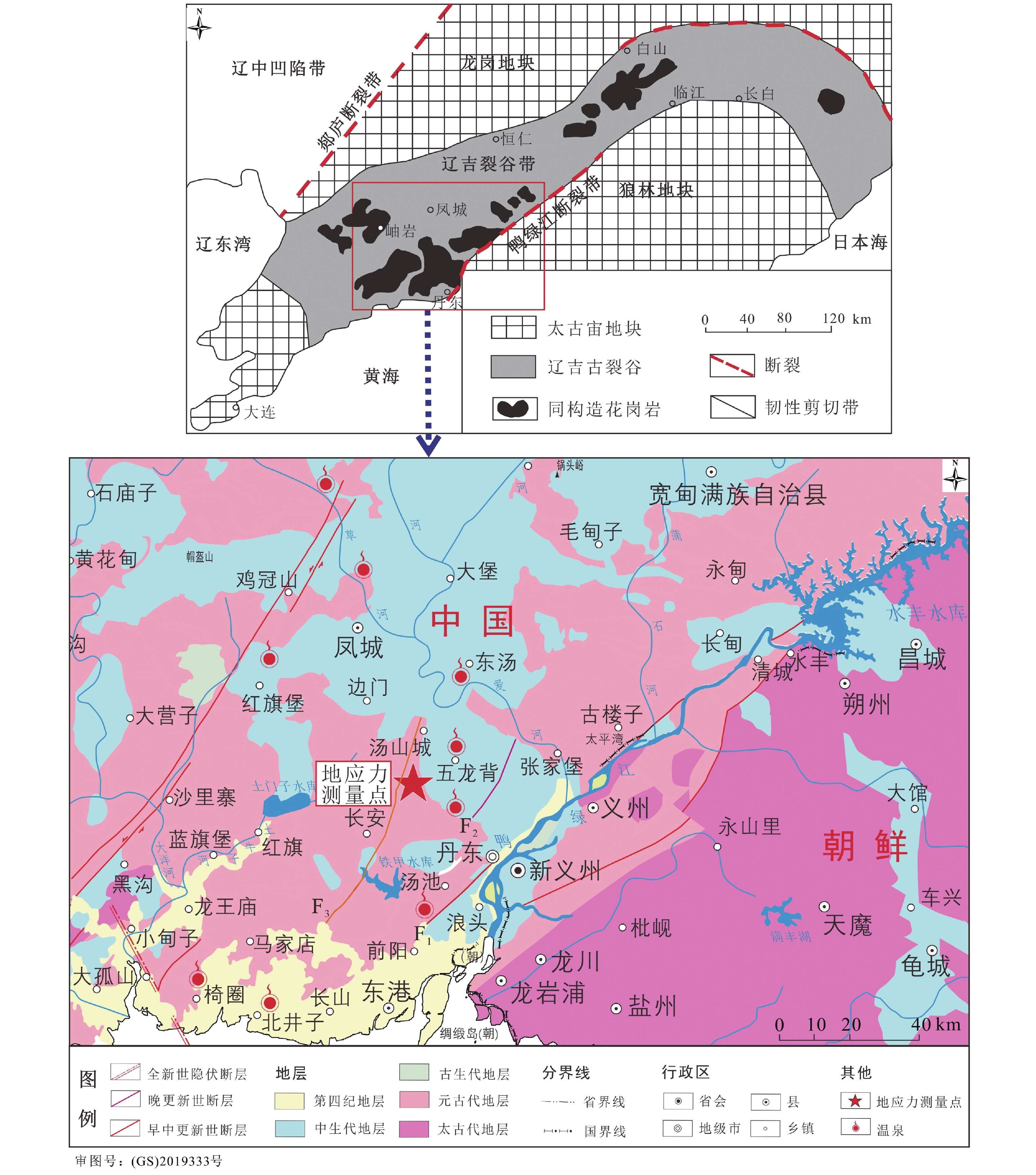
 下载:
下载:
